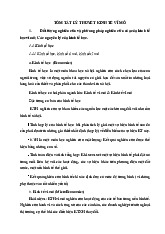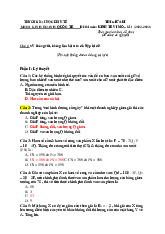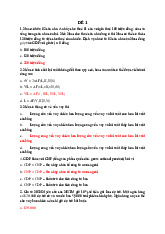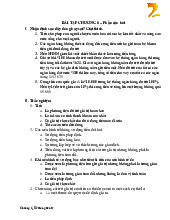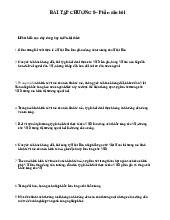


Preview text:
lOMoARcPSD| 49964158 CHAPTER 6 1. Money
a. is the perfect store of value b. is the most liquid asset
c. has intrinsic value in any form of money
d. All of the above sentences are correct
2. Economies that don't use money require a. Use fiat money. b. Use commodity money.
c. Double coincidence of interests in transactions.
d. Money acts as a store of value but not a medium of exchange.
3. When an economy uses silver as money, that economy's money
a. Seen as a store of value, but not as a medium of exchange
b. Considered an intermediary of exchange but not a unit of account c. Is fiat money d. Has intrinsic value
4. Money's store of value function can be specifically described as:
a. A conventional measure for pricing.
b. As a guarantee for coincidence of demand.
c. Something that can be kept and then exchanged for other goods.
d. Is a generally accepted unit of exchange.
5. Which of the following is not in M1 ?
a. VND 50,000 bill in your wallet
b. 2 million VND in ATM account
c. 10 million dong in savings account d. All in M1 lOMoARcPSD| 49964158
6. In a 100% reserve banking system, if the public decides to reduce the amount of
cash they hold by increasing the amount deposited in their ATM accounts, then a. M1 will increase b. M1 will decrease c. M1 is unchanged
d. M1 can increase or decrease
7. A person transfers 10 million VND from a 3-month term savings book to a term savings book, then: a. M1 and M2 decrease.
b. M1 decreases and M2 increases.
c. M1 decreases and M2 does not change.
d. M1 increases and M2 remains unchanged
8. Assuming a reserve requirement ratio of 20%, a bank receiving a deposit of
VND100 million will be able to:
a. Loan additiona 500 million.
b. Loan additional 100 million.
c. Loan additional 80 million.
d. Loan additional 20 million. 9. Open market operations:
a. Relating to the central bank buying and selling corporate bonds.
b. Relating to the central bank buying and selling government bonds.
c. Relating to the central bank lending money to commercial banks.
d. Relating to the central bank's control of the exchange rate.
10. When making purchases on the open market, the Central Bank
a. Buy government bonds, and in this way increases the money supply
b. Buy government bonds, and in this way reduces the money supply
c. Sell government bonds, and in this way increases the money supply
d. Sell government bonds, and in this way reduces the money supply lOMoARcPSD| 49964158
11. Money supply increases when:
a. Government spending increases.
b. The central bank buys government bonds from the public.
c. A resident buys bonds of FPT.
d. FPT sells shares to the public and uses the revenue to build a new factory.
12. To increase the money supply, the Central Bank can
a. Buy government bonds or raise the discount rate
b. Buy government bonds or reduce the discount rate
c. Sell government bonds or raise the discount rate
d. Sell government bonds or reduce the discount rate
13. If the central bank sells government bonds for $1 million, the money supply will: a. Reduce by $1 million b. Increase by 1 million USD.
c. Reduce more than 1 million USD.
d. Increase more than 1 million USD.
14. If the reserve requirement ratio is 10%, banks do not hold excess reserves and the
public only has deposit accounts and does not hold cash. When the Central Bank sells
$10 million bonds to the public,
a. money supply will increase by $10 million
b. money supply will decrease $10 million
c. money supply will increases by $100 million
d. money supply will decrease by $100 million
